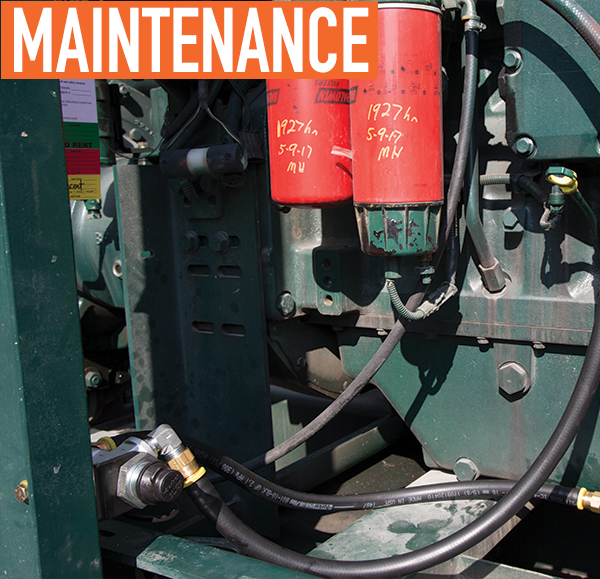A trip to the doctor’s office for a regularly scheduled health exam is a proactive way to know and correct any minor medical issues before they become big problems. The same holds true for preventive maintenance of equipment and vehicles. Commercial motor vehicles are inspected and maintained on a routine basis to detect and fix any small defects that might surface.
Preventive maintenance ensures a fleet truck is safe, reliable, and operating at the highest level of performance. These programs are most effective when scheduled on a timely basis or based on distance traveled, and not when an issue arises. Reactionary maintenance can result in costly repairs and significant downtime during crucial times when vehicles need to be on the road.
The benefits of performing regular preventive maintenance outweigh the consequences of not doing it, and in fact, research reveals 80 percent of maintenance issues can be addressed by performing preventive maintenance.
CHECK IT ALL
When it comes to service intervals, which components of a commercial motor vehicle should be inspected? Well, everything. From warning and control lamps and hood attachments to air compressors and drive belts, every square inch of the vehicle needs to be evaluated. This includes engine oil.
First and foremost, oil is the lifeblood of any engine and provides the necessary nutrients to reduce friction, transfer heat, protect against wear, and minimize corrosion deposits, debris, and contaminants. Fifty years ago, changing oil on a heavy-duty vehicle was performed as frequently as every 500 miles. Today, it’s possible to have an oil drain interval as high as 20,000 miles or more.
There are a variety of oil change processes available for commercial motor vehicles. They are designed to be self-contained, pneumatic, and completely mobile. In addition, advancements made in gasoline-refining technology decrease combustion pollutants, helping to reduce engine oil contaminants. Additives improve the ability of engine oil to maintain proper lubrication quality when contaminated.
OIL CHANGE DIFFICULTY
Changing engine oil sounds simple enough, right? Unfortunately, it’s easier said than done, as there are a multitude of challenges and hidden costs associated with the conventional oil change. Training technicians and mechanics on complex oil change equipment and delicate processes can be tedious. Along with labor, oil testing and inspections are necessary to ensure the proper oil change. But most importantly, the traditional way of changing oil exposes workers to rigorous conditions and puts them at risk of safety and ergonomic hazards. Performing the job in a set sequence with the proper tools makes things easier, but the likelihood of a mess, or worse, still exists with oil changes.
QUICKFIT DIFFERENCE
Progress was made to simplify the oil change process through a standardized operating approach. Parker-Hannifin recently introduced the QuickFit™ Oil Change System. The system uses a QuickFit Valve that acts as a single connection point for purging the filter, evacuating used oil, and refilling with new oil. By using one connection point, you receive less variability during maintenance checks.
BENEFITS
Once installed, the QuickFit Oil Change System features an ergonomic design that allows for easier access to even the most cramped and isolated engine compartments. This greatly reduces exposure to fluids and lowers the possibility of slips, falls, and burns. Plus, oil changes can be completed from start to finish in less than 30 minutes.
Even with today’s high-tech fleets, the QuickFit system offers a solution that combines incredible ease-of-use with comprehensive functionality. Maintenance becomes simple, productivity goes up, the risk of spills and contamination is virtually eliminated, and it works for engines and machinery across multiple applications.
A key component of operating a successful business involves getting a product to its final destination on time and in great condition. This means commercial motor vehicles must operate at peak performance. Preventive maintenance is a proactive approach to maintaining fleets through scheduled services, inspections, and repairs to prevent potential problems and maximize vehicle availability. This contributes to lower operating costs, increases in labor productivity, and optimizes uptime and lifecycle of the vehicle.
SIMPLIFY AND CONQUER
It’s not an exaggeration to say oil is the lifeblood of all engines. Commercial motor vehicles rely on clean engine oil to lubricate, protect, and cool. Regular oil changes are an essential preventive maintenance function to maximize the productive life of the equipment. The QuickFit Oil Change System simplifies a crucial aspect of fleet maintenance, allowing technicians and mechanics to change the oil in a matter of minutes and focus more time on other key services required on heavy-duty trucks. Simplifying this one process increases the efficiency of your service team, granting more time to use their valuable knowledge and skills.
FOR MORE INFORMATION
Find out more about Parker-Hannifin’s QuickFit Oil Change System, visit www.parker.com/quickfit.
MODERN WORKTRUCK SOLUTIONS: AUGUST 2018 ISSUE
Did you enjoy this article?
Subscribe to the FREE Digital Edition of Modern WorkTruck Solutions magazine.
![]()





